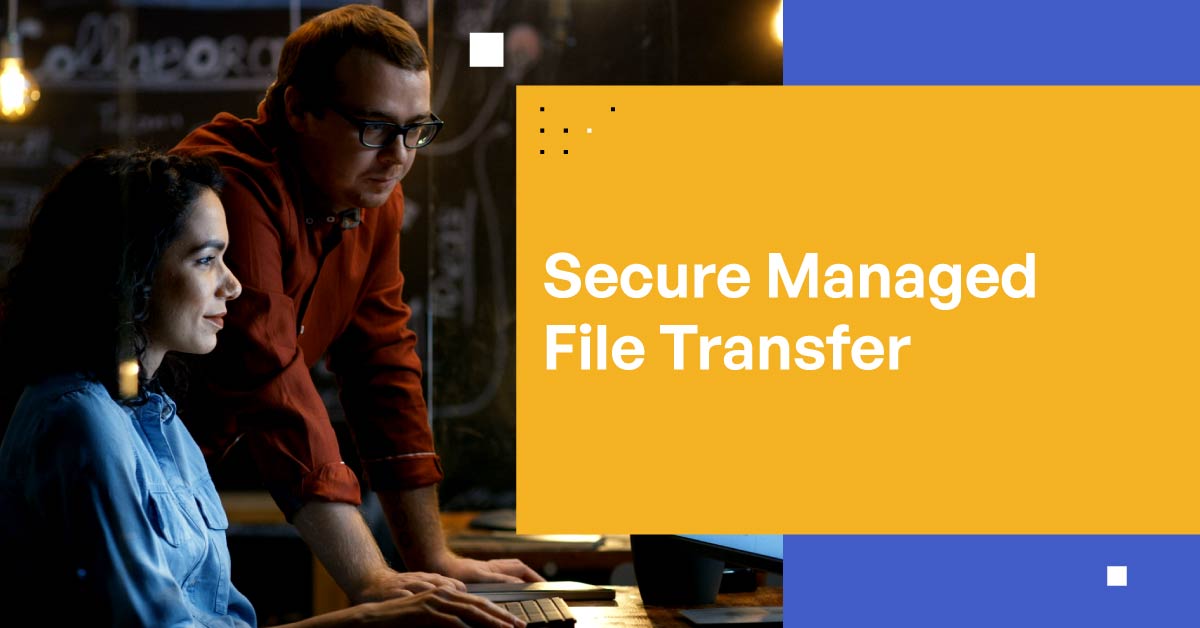Understanding Secure Managed File Transfer
In light of increased cyberattacks targeting sensitive content and subsequent government oversight, safeguarding of sensitive information during transit has never been more crucial. Secure managed file transfer, or secure MFT, represents a pivotal advancement in how organizations transmit data between systems, individuals, and partners securely.

This guide delves into the essence of secure managed file transfer, emphasizing its importance and the distinctive benefits it offers over conventional file transfer methodologies, including traditional managed file transfer (MFT) applications.
Still debating between FTP and managed file transfer? Here are six reasons why managed file transfer is better than FTP.
What is Secure Managed File Transfer?
Secure managed file transfer is a holistic solution designed to provide secure, reliable, and efficient data transfers. Unlike traditional file transfer protocol (FTP) which lacks adequate security measures, secure managed file transfer integrates comprehensive security features, including encryption, secure file transfer protocols like secure file transfer protocol (SFTP) or FTPS, and automated workflows to ensure data is not only transmitted securely but also managed efficiently throughout its lifecycle.
Secure managed file transfer’s significance in today’s business environment cannot be overstated. With alarming increases in cyberattacks and data breaches, organizations are under constant threat of compromising sensitive information. Secure managed file transfer addresses these challenges by offering a fortified method of transferring data, thus safeguarding against unauthorized access, data leaks, and ensuring compliance with stringent data protection regulations.
Secure Managed File Transfer: Key Features
Secure managed file transfer incorporates a range of security, compliance, and efficiency features aimed at ensuring high levels of data security and operational productivity. Understanding these features is vital for organizations looking to enhance their data transfers. These features include, but are not limited to:
- Encryption of data at rest and in transit: encryption is bolstered by the implementation of secure file transfer protocols such as SSH File Transfer Protocol (SFTP) or File Transfer Protocol Secure (FTPS), which offer an additional layer of security compared to traditional FTP.
- Comprehensive user authentication processes: Authentication procedures ensure that only authorized users can access and transfer data, thereby significantly reducing the risk of data breaches. Moreover, secure MFT systems come equipped with detailed audit logs and reporting functions, allowing for real–time tracking of file movements and facilitating audits for compliance purposes.
- Automation: Productivity skyrockets when organizations can streamline their data transfer processes, reduce manual errors, and increase overall efficiency. This is particularly beneficial for businesses that handle a large volume of data transfers on a daily basis.
- Scalability: High scalability ensures organizations can accommodate their growing data transfer needs without compromising on performance or security.
Benefits of Implementing Secure Managed File Transfer
Implementing secure managed file transfer into a business’ operations yields significant benefits. The primary advantage is the enhanced security it provides for sensitive data, which is crucial in today’s digital landscape characterized by escalating cyber threats.
Secure managed file transfer systems ensure data integrity and confidentiality through end–to–end encryption and secure file transfer protocols. This level of security is indispensable for organizations handling sensitive information, such as financial records, personal employee details, or confidential business documents.
Additionally, secure managed file transfer solutions are instrumental in ensuring compliance with various data protection regulations such as GDPR, HIPAA, PCI DSS, and CMMC. These solutions come equipped with features tailored to meet the specific requirements of these regulations, thus simplifying the compliance process for organizations and reducing the risk of costly penalties.
Moreover, the automation capabilities of secure managed file transfer systems streamline data transfer processes, minimize human error, and enhance operational efficiency. This allows organizations to allocate their resources more effectively and focus on their core business activities.
Another significant advantage of secure managed file transfer is the trust it fosters among business partners and customers. By demonstrating a commitment to data security and regulatory compliance, organizations can strengthen their relationships with external parties and secure a competitive edge in the market.
How Secure Managed File Transfer Works
At its core, secure managed file transfer is engineered to enhance the security and efficiency of data transmission processes. It accomplishes this through several key functionalities. For example, end–to–end encryption ensures data integrity and confidentiality during transit. Robust authentication mechanisms verify the identity of users accessing the system. Finally, comprehensive logging and reporting capabilities provide visibility and auditability of all file transfer activities.
Moreover, secure MFT is designed to streamline and automate file transfer workflows, thereby minimizing human error, reducing the reliance on inefficient legacy systems, and supporting regulatory compliance efforts. Whether it’s automating the transfer of financial documents, securely sending patient health information, or distributing confidential business agreements, secure managed file transfer plays a critical role in business operations.
Secure Managed File Transfer vs. Legacy File Transfer: Key Differentiators
Secure managed file transfer represents a significant evolution from legacy file transfer methods, offering enhanced security, compliance, and management features tailored for modern business needs. Unlike traditional file transfer protocols, secure managed file transfer provides robust protection and ensures compliance with stringent data protection regulations.
As organizations continue to prioritize data security, understanding the key differentiators between secure managed file transfer and legacy file transfer systems is crucial for maintaining the integrity and confidentiality of critical data. Here is a list of key differentiators between secure managed file transfer and legacy file transfer solutions:
- Encryption: Secure managed file transfer employs robust encryption standards like AES and SSL/TLS during data transit and at rest, unlike many legacy systems that transfer data unencrypted or use weak encryption methods.
- Compliance: Modern secure managed file transfer solutions are built to meet compliance requirements with GDPR, HIPAA, and other regulations, something that most legacy systems cannot guarantee without significant modifications.
- Automation: Secure managed file transfer solutions offer advanced automation capabilities, reducing manual intervention and thus, the risk of human error, a common shortfall in legacy systems.
- Audit Logs: Comprehensive logging and reporting functionalities in secure MFT systems provide clear visibility into all file transfer activities, aiding in security audits and compliance—a contrast to the opaque or non–existent logging in many older systems.
- Scalability: Secure managed file transfer solutions are designed to scale with an organization’s needs, supporting a growing number of files, sizes, and complex workflows, unlike legacy systems which often struggle to scale efficiently.
Enhancing Security and Compliance with Secure Managed File Transfer
Secure managed file transfer profoundly impacts an organization’s security posture and compliance capacity. By implementing secure managed file transfer, businesses can safeguard against cyber threats that often lead to data breaches, align with data protection standards, and instill trust among stakeholders.
Furthermore, secure MFT’s compliance with regulations like CMMC, PCI DSS, HIPAA, and GDPR ensures organizations can confidently navigate the complex landscape of data privacy laws. The intrinsic security features within secure managed file transfer such as encryption, secure protocols, and audit logs directly contribute to fulfilling regulatory requirements, thereby mitigating the risk of costly legal penalties, financial losses, or reputational damage.
What Can Happen if You Don’t Use Secure Managed File Transfer?
Traditional file transfer protocols and legacy managed file transfer solutions can expose organizations to a wide spectrum of risks. These include the potential for catastrophic data breaches, exposing sensitive PII/PHI and intellectual property. In most cases, data breaches result in litigation, financial losses, and irreparable damage to an organization’s reputation.
But that’s not all. Once an organization has suffered a data breach, whether accidentally or at the hands of a bad actor, it also triggers a compliance violation. Non–compliance can lead to hefty fines and restrictions, further exacerbating the operational and financial strain on an organization.
Unless organizations embrace secure file transfer technologies, including secure managed file transfer, they will invite business, financial, and reputational risk.
Kiteworks Helps Organizations Protect Their Sensitive Content With Secure Managed File Transfer
Secure managed file transfer is an indispensable tool for modern organizations aiming to protect sensitive data during transfer, ensure compliance with stringent data protection regulations, and enhance operational efficiency. By incorporating robust encryption, secure file transfer protocols, user authentication, and detailed logging and reporting capabilities, secure MFT offers a comprehensive solution that significantly mitigates the risks associated with data transfers.
The benefits of implementing secure MFT extend beyond enhanced security and compliance. They also include improved operational efficiency through automation, scalability to accommodate growing data transfer needs, and the fostering of trust among business partners and customers.
With secure managed file transfer, organizations can safeguard their data, ensure regulatory compliance, and maintain a competitive edge in the digital era. As a result, secure managed file transfer is not just a strategic asset; it’s a fundamental component of a business’ robust data security and compliance program.
The Kiteworks Private Content Network, a FIPS 140-2 Level validated secure file sharing and file transfer platform, consolidates email, file sharing, web forms, SFTP and managed file transfer, so organizations control, protect, and track every file as it enters and exits the organization.
Kiteworks secure managed file transfer provides robust automation, reliable, scalable operations management, and simple, code-free forms and visual editing. It is designed with a focus on security, visibility, and compliance. In fact, Kiteworks handles all the logging, governance, and security requirements with centralized policy administration while a hardened virtual appliance protects data and metadata from malicious insiders and advanced persistent threats. As a result, businesses can transfer files securely while maintaining compliance with relevant regulations
Kiteworks secure managed file transfer supports flexible flows to transfer files between various types of data sources and destinations over a variety of protocols. In addition, the solution provides an array of authoring and management functions, including an Operations Web Console, drag-and-drop flow authoring, declarative custom operators, and the ability to run on schedule, event, file detection, or manually.
Finally, the Kiteworks Secure Managed File Transfer Client provides access to commonly-used repositories such as Kiteworks folders, SFTP Servers, FTPS, CIFS File Shares, OneDrive for Business, SharePoint Online, Box, Dropbox, and others.
In total, Kiteworks secure managed file transfer provides complete visibility, compliance, and control over IP, PII, PHI, and other sensitive content, utilizing state-of-the-art encryption, built-in audit trails, compliance reporting, and role-based policies.
To learn more about Kiteworks Secure Managed File Transfer and its security, compliance, and automation capabilities, schedule a custom demo today.

